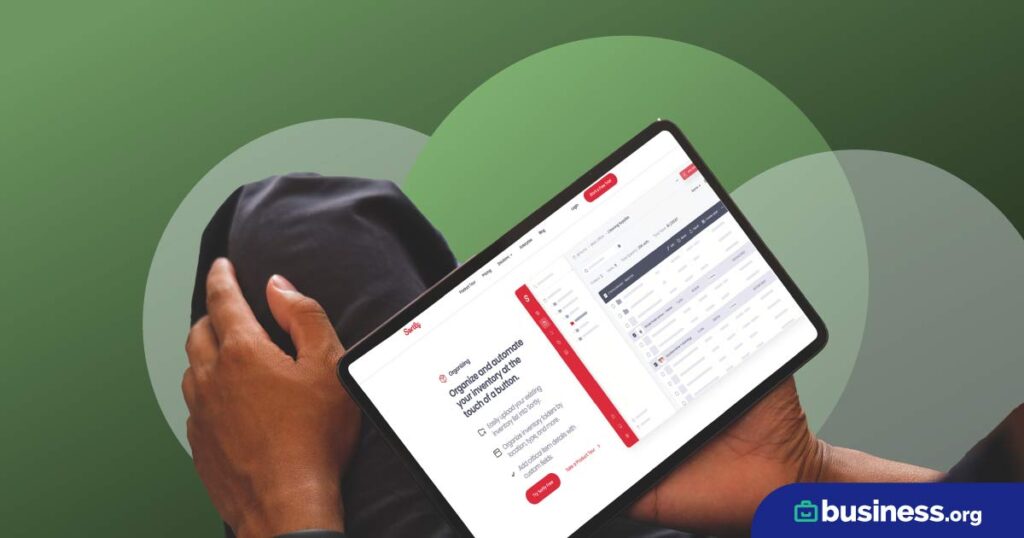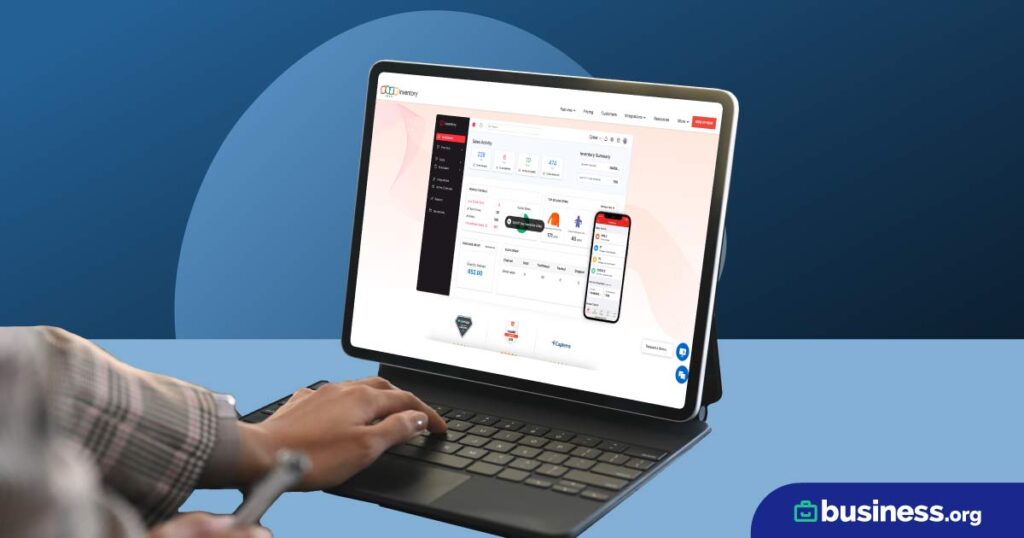We are committed to sharing unbiased reviews. Some of the links on our site are from our partners who compensate us. Read our editorial guidelines and advertising disclosure.
Ordoro Review: Pricing, Plans, and Features
Data as of 12/13/22. Offers and availability may vary by location and are subject to change.
Ordoro is one of our favorite web-based inventory management software solutions because it makes supply chain management a cinch.
In plain English, Ordoro focuses on simplifying the shipping process for your business. Ordoro is primarily a shipping and supply chain management software, so the entire platform focuses on customer order fulfillment and minimizing wait time during the product reordering process.
This makes Ordoro particularly good for dropshippers and businesses running tight just-in-time (JIT) systems, but it isn’t great for brick-and-mortar retailers. Check out our complete review below to get all the details.
Ordoro plans and pricing
At first glance, Ordoro seems to have one of the cheapest inventory management solutions on the market. And while Ordoro’s usual $59-per-month pricing for its Express plan is certainly cheaper than most inventory control software, there is a catch:
The Express plan doesn’t include any inventory management features.
Data as of 12/13/22. Offers and availability may vary by location and are subject to change.
To get any inventory management features, you’ll have to sign up for the Pro plan—and the price jumps all the way to $499 per month. That’s nearly double what you’d pay with Cin7 or Unleashed.
Of course, it’s not all bad news. Unlike other inventory management platforms, Ordoro doesn’t charge a higher rate if you have a high-volume month. Instead, you pay a flat monthly fee.
Ordoro is best for ecommerce businesses
Because of its focus on shipping, we think Ordoro works best for ecommerce sites. Ordoro is all about making your supply chain fast and efficient so you can get your products when you need them, minimize your inventory holding costs, and ship orders to your customers promptly.
I started selling travel gear on my site only recently, so I’m relatively new to ecommerce. Connecting the dots between the shopping cart and shipping platforms was very difficult for me.
Ordoro helped me set up and ship in a fast, simple, secure way. It integrated with our store seamlessly, allowing me to focus my time on the content of the site. Ordoro is without question one of the best shipping tools I have used.

Ordoro also offers a lot of dropshipping features, which makes it an easy choice for businesses that forward customer orders on to product owners.
However, Ordoro doesn’t offer demand forecasting, manufacturing inventory features, or enterprise-level resources for larger companies. So if you’re looking for an inventory software solution that can handle more complex retail and manufacturing needs, you may want to try a different solution.
Ordoro pros and cons
In our opinion, Ordoro excels at customer service. The software is easy to use, delivers top-notch dropshipping features, and even offers discounted shipping rates. But with no inventory management features on its introductory plan, slow syncing across the system, and a lack of key features (like demand forecasting), Ordoro isn’t a great pick for any business that doesn’t use an ecommerce business model.
Ordoro pros
Ordoro works in partnership with Pitney Bowes, an enterprise-level shipping and ecommerce solution that services over 90% of the Fortune 500.1 Ordoro leverages that connection to provide its users with top-notch shipping and dropshipping features. Most notably, the service offers discounted USPS shipping rates to help your business maximize its bottom line.
Ordoro is also easy to use, with a simple dashboard that makes it easy to find what you’re looking for. Ordoro can also sync with all your ecommerce platforms, so you can run nearly every aspect of your business in one place.
And the cherry on top: users love Ordoro’s customer support. Between the company’s helpful chat, phone, and email representatives, its YouTube channel, and its online help articles, it’s easy to get answers and solutions to all your questions and problems.
Ordoro cons
As we’ve already mentioned, Ordoro doesn’t offer any inventory management features on its Express plan, so you’re stuck paying $499 per month if you want a way to track your inventory levels.
Ordoro is also slower than other providers when it comes to syncing sales and shipping data. Your system updates only once per hour—hardly ideal if your inventory is low and multiple sales come through within the hour.
Finally, Ordoro is missing a few key features that other inventory management providers consider standard fare. While other platforms let you access your account from your iOS or Android device, for instance, Ordoro doesn’t. It also falls short when it comes to retail and manufacturing features, so if your business falls into one of those categories, Ordoro may not be robust enough to match your needs.
There is good news: Ordoro is introducing new features—like the Bill of Materials for manufacturing—showing that it is working to meet customer demand. And if you need help with your sales forecasting, you can integrate with Inventory Planner for forecasting.
Key features of Ordoro
Inventory management
Ordoro offers a lot of your typical inventory management features. You can automatically track your inventory levels and get notifications anytime your stock drops low enough that you need to order more. You can also issue purchase orders, and Ordoro’s multi-channel fulfillment lets you manage customer orders from all your sales channels.
While most of Ordoro’s inventory management offerings are lackluster, there are a couple of features that stand out.
For starters, Ordoro lets you create master products within your system, allowing you to sell a single item across multiple sales channels while creating custom branded descriptions and images for each channel. You can also limit the product quantity seen by the customer to create a sense of scarcity, and you can opt to strategically oversell your goods.
With Ordoro’s Enterprise plan, you can also use supplier feeds to update quantities in your product listings based on the amount of stock your vendors have on hand. This allows you to sell products before you’ve actually received them and prevents stockouts that may drive away potential customers.
Shipping
If there’s one thing Ordoro does really well, it’s shipping.
Shipping can be a major chore with other inventory management platforms—especially if you’re shipping a lot of orders at a time. Nobody wants to fill out shipping forms, print labels, and shop for the best shipping method on every individual order.
With Ordoro, you can sort your orders via filterable tags, grouping customer orders by shipping method, geographical area, and more. From there, you can mix and match shipping methods, apply Ordoro’s special USPS rates (discounted up to 67%2), and purchase your postage, shipping insurance, and more—all from your Ordoro app.
Once you’ve determined your shipping methods and paid for postage, Ordoro lets you print your shipping labels in large batches of up to 999 orders at once—and unlike other platforms, Ordoro lets you send labels directly to your printer instead of making you convert your labels into PDF documents first. Ordoro will even automatically send your customers an email with their order status and a tracking number.
Best of all, Ordoro offers all these features on all your orders from all your sales channels. So even if a customer orders a product from your Shopify store instead of your personal website, you’ll still be able to manage and process that order within your Ordoro app.

By signing up I agree to the Terms of Use and Privacy Policy.
Dropshipping
As every dropshipper knows, good communication with your vendors is crucial to making sure your customers’ orders get fulfilled accurately and on time. Fortunately, Ordoro’s dropshipping features make seller-vendor communication easy.
Once you’ve set up your Ordoro account, you can add vendors to your system and assign them to products on your sales channels. That way, when customers order something, your system can automatically route those orders to the right vendor. This setup allows your customers to enjoy a faster turnaround time, which promotes greater customer satisfaction.
Of course, with an Enterprise plan, you can take it to the next level by setting up Vendor Portals.
With a Vendor Portal, your dropshipping vendor can log into your Ordoro account and view all the orders you’ve placed with them. Then they can get to work fulfilling those orders without you needing to call, email, or message them. Vendors can even print your brand’s custom shipping labels, send tracking info, and update your business’s inventory counts—all of which saves you valuable time.


Automation
While Ordoro doesn’t offer quite as much automation as other options, its automation features are nonetheless impressive.
Let’s say a customer purchases three items via your Shopify account. If the order contains products supplied by different vendors, Ordoro automatically splits the order within your system, then sends each new order to the appropriate vendors for fulfillment.
If you’re using a compatible cloud-based accounting software, Ordoro also automatically updates your cost of goods sold and other relevant data—less math for you, right?
Finally, Ordoro allows you to assign tags to each product in your system based on a number of criteria (like weight, SKU number, and destination). Ordoro then automatically groups those orders based on their tags, allowing you to apply shipping presets to hundreds of similar orders at once. You can also create automation rules based on tag data (like “All packages over 16 ounces will be sent via UPS”).
Long story short: Orodoro takes all the mundane, repetitive tasks out of your shipping and customer fulfillment, leaving you more time to focus on the rest of your business.
Kitting
Ordoro is also unique in the way it incorporates product kitting (a.k.a. bundling individual products or components into a single sellable item).
Ordoro lets you group products and components into the following:
- Single-level kits: a bundle of multiple related products or components
- Multi-level kits: single products made up of multiple smaller kits
- Fractional kits: bundles that contain fractional quantities of multiple products—like a cake mix with proportional amounts of flour, sugar, and baking soda
Ordoro can even handle kits with varying quantities, allowing your customers to customize the number of single components within their bundle.
Ordoro tracks the inventory levels of components for each of your kits across multiple warehouses. That way, you can accurately determine how much of each kit you have in stock based on how much of each component you have on hand.
This allows you to better keep track of your inventory, even on bulk items that you sell in various package sizes.
Analytics
Ordoro’s analytics aren’t the most robust—especially compared to other options like Cin7. But you are able to manage the basics.
With Ordoro, you can track both your revenue and costs, then analyze that data within subsets like suppliers, geographical area, shipping methods, and sales channels. This gives you insight into your business’s performance, so you can see which suppliers help you turn the most profit, which carriers help you minimize shipping costs, which sales channels produce the highest number of sales, and which areas of the world like your products best.
Beyond that, though, Ordoro does offer a couple of valuable insights. For one, it lets you track how much cash you have tied up in your inventory. You can also gauge which products are selling well (and which aren’t). You can even track your top customers to help you decide which products to offer next.

Integrations
Inventory management software is most efficient when it communicates with your other business software. To that end, Ordoro offers over 40 integrations with other business software, including the following:
- Sales channels: Shopify, BigCommerce, Amazon, eBay, Etsy, WooCommerce, Magento, and more
- Shipping carriers: USPS, FedEx, UPS, DHL, and more
- Fulfillment services: Fulfillment By Amazon, 3PL Central, Shipwire, and more
- Suppliers: Moteng, Barco Uniforms, CWR Wholesale Distribution, Multimedia Technology
- Accounting: QuickBooks, Xero
- Point-of-Sale: Shopify, Square
- Other tools: Inventory Planner, Inventory Source, Gorgias, SPS Commerce, and more
Ordoro is also an open API, meaning you can build custom integrations with any vendors Ordoro doesn’t work with already. Of course, you’ll need to know a bit about coding first—or be able to hire someone who can do it for you.

Customer Support
One of the things we like about Ordoro is the fact that the service doesn’t offer priority support. Now you might be thinking, “Isn’t that a bad thing?” Not necessarily.
With Ordoro, all customers are entitled to the same standard of treatment—no prioritizing customers with deeper pockets who can afford high-end plans and extra customer support membership. Instead, Ordoro’s support channels are available to all users via phone, email, chat, or the service’s online forums and help center.
The only fault we could find with Ordoro’s support system is that a couple of online resource articles were out of date—nothing a typical business owner can’t handle.


The takeaway
Ordoro isn’t our favorite inventory management app, but it’s still a top contender for many businesses—particularly if you run an ecommerce store or run a dropshipping business model. If not, the cost of the service and its lack of vital sales features make Ordoro a poor value.
Overall though, Ordoro is a strong inventory management system with an impressive number of features and dropshipping capabilities. Plus, automation and analytics help you keep track of inventory. The big detriment is the price, but if you have an ecommerce business, Ordoro can be your one-stop-shop for inventory management—and that's too good to pass up.
Looking for something for your business? Jump on over to our best inventory management software guide to find the right software for you.
Related content
Ordoro FAQs
Ordoro is a cloud-based software that offers supply chain management, inventory management, and shipping solutions for small to large businesses. It’s distinguished by its attention to shipping and dropshipping features, making it a perfect fit for ecommerce businesses looking to keep tabs on all their customer orders.
Because of its attention to shipping, we think Ordoro is best for businesses that send a lot of packages. Based on that, we believe Ordoro would work best for ecommerce businesses—though the service’s excellent dropshipping features would also make it a good choice for dropshippers and retail businesses running a just-in-time (JIT) system.
What is dropshipping?
Dropshipping means selling products that are owned by another vendor. When you receive an order, you simply forward that order to the product owner, who then packages and ships the order on your behalf. When done correctly, dropshipping is a mutual partnership between the business owner and the vendor in which both groups are able to make money from each customer transaction.
Do I need inventory software?
Inventory tracking software is not an absolute necessity—you certainly can get by without it. But tracking your inventory by hand leaves you vulnerable to mistakes (we’re only human) that could cost your company hundreds or thousands of dollars. What’s more, tracking your inventory by hand takes a lot of time—time you could be using to interact with customers and grow your business.
So, while you don’t strictly need inventory management software, we’d definitely recommend it.
Methodology
For our review of Ordoro, we looked at pricing and plans, features, integrations, customer service, and ease of use when tracking inventory on the platform. We took into account how other inventory management systems perform—especially in our pricing comparison—and ranked Ordoro on a scale out of five. Our review is subjective and subject to change as new features and pricing become available.
Disclaimer
At Business.org, our research is meant to offer general product and service recommendations. We don't guarantee that our suggestions will work best for each individual or business, so consider your unique needs when choosing products and services.
Sources
- Pitney Bowes, "Our Company," Oct. 26, 2021. Accessed December 13, 2022.
- Ordoro, "USPS Shipping Carrier Guide." Accessed December 13, 2022.









